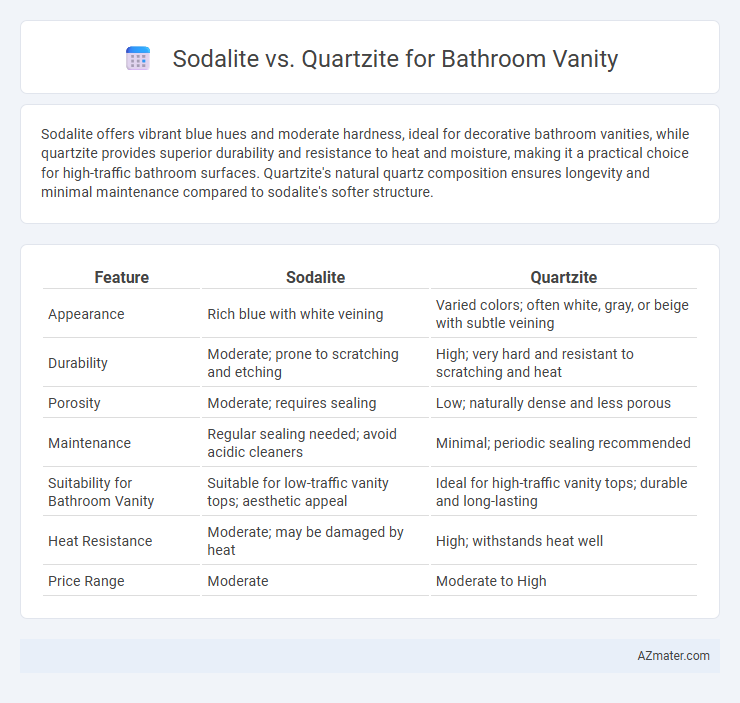Sodalite offers vibrant blue hues and moderate hardness, ideal for decorative bathroom vanities, while quartzite provides superior durability and resistance to heat and moisture, making it a practical choice for high-traffic bathroom surfaces. Quartzite's natural quartz composition ensures longevity and minimal maintenance compared to sodalite's softer structure.
Table of Comparison
| Feature | Sodalite | Quartzite |
|---|---|---|
| Appearance | Rich blue with white veining | Varied colors; often white, gray, or beige with subtle veining |
| Durability | Moderate; prone to scratching and etching | High; very hard and resistant to scratching and heat |
| Porosity | Moderate; requires sealing | Low; naturally dense and less porous |
| Maintenance | Regular sealing needed; avoid acidic cleaners | Minimal; periodic sealing recommended |
| Suitability for Bathroom Vanity | Suitable for low-traffic vanity tops; aesthetic appeal | Ideal for high-traffic vanity tops; durable and long-lasting |
| Heat Resistance | Moderate; may be damaged by heat | High; withstands heat well |
| Price Range | Moderate | Moderate to High |
Introduction to Sodalite and Quartzite
Sodalite is a vibrant blue gemstone known for its deep hues and unique white veining, making it an eye-catching choice for bathroom vanities with a distinctive aesthetic appeal. Quartzite, a naturally hard metamorphic rock formed from sandstone, offers exceptional durability and resistance to heat and scratches, ideal for high-traffic bathroom environments. Both materials provide unique visual characteristics and functional benefits, with sodalite emphasizing striking color contrast and quartzite delivering long-lasting performance.
Physical Characteristics Comparison
Sodalite features a rich blue color with white veining, providing a distinct, vibrant appearance, while quartzite displays a more natural stone look with subtle veining and a range of colors from white to gray and beige. Quartzite is typically harder and more resistant to scratches and heat, making it highly durable for bathroom vanity surfaces. Sodalite's lower hardness and porosity require more careful maintenance to prevent staining and damage compared to quartzite's superior durability and resistance.
Color and Aesthetic Differences
Sodalite features vibrant deep blue hues with white veining, creating a bold and striking aesthetic that stands out in bathroom vanities. Quartzite offers a more subtle appearance with a wide spectrum of colors including whites, grays, and soft earth tones, providing a natural and elegant look. The choice between sodalite's rich, dramatic color palette and quartzite's understated, versatile beauty depends on the desired visual impact for the bathroom space.
Durability and Scratch Resistance
Sodalite offers moderate durability and scratch resistance, making it suitable for bathroom vanity surfaces with light to medium use, while Quartzite is highly durable and exhibits superior scratch resistance due to its natural quartz content and hardness. Quartzite's density and resistance to abrasion make it ideal for high-traffic bathroom environments where maintaining an unblemished surface is critical. Choosing Quartzite over Sodalite ensures long-lasting performance and minimal wear, enhancing the vanity's longevity and aesthetic appeal.
Stain and Water Resistance
Sodalite offers moderate stain resistance but requires regular sealing to maintain water resistance, making it less durable in constantly wet environments like bathroom vanities. Quartzite exhibits superior water resistance and exceptional hardness, providing excellent protection against stains and humidity without frequent maintenance. Choosing quartzite ensures a more resilient and long-lasting surface ideal for daily exposure to moisture and spills.
Maintenance and Cleaning Requirements
Sodalite requires gentle cleaning with mild soap and water to prevent damage from harsh chemicals and should be sealed regularly to maintain its vibrant blue color and resist stains. Quartzite offers superior durability and scratch resistance, making it easier to clean with standard household cleaners without worrying about etching or discoloration. Both materials benefit from prompt spill cleanup, but quartzite typically demands less frequent sealing and maintenance, enhancing its practicality for bathroom vanity surfaces.
Cost and Budget Considerations
Sodalite typically costs between $50 to $100 per square foot, making it a more affordable option for bathroom vanities compared to quartzite, which ranges from $70 to $150 per square foot due to its durability and natural stone appeal. Budget-conscious homeowners may prefer sodalite for its vibrant blue tones and lower price point, while those prioritizing long-term value might invest in quartzite for its superior scratch and heat resistance. Installation and maintenance costs also vary, with quartzite demanding professional sealing and sodalite requiring less intensive upkeep, influencing overall expenses.
Installation Challenges and Tips
Sodalite's softer nature compared to quartzite requires careful handling during installation to prevent chipping and scratching, making it essential to use sharp diamond blades and gentle polishing techniques. Quartzite's durability and hardness pose challenges in cutting and drilling; installers should employ water-cooled tools and slow feed rates to avoid excessive heat and tool wear. Both materials benefit from professional assessment to ensure proper adhesive selection and substrate preparation for long-lasting bathroom vanity installations.
Best Applications in Bathroom Vanities
Sodalite offers striking deep blue hues with white veining, making it ideal for bold, decorative bathroom vanities that serve as focal points. Quartzite provides superior hardness, durability, and resistance to scratches and heat, making it a practical choice for high-traffic bathroom vanities requiring long-lasting performance. Both materials resist moisture well, but quartzite's natural strength makes it better suited for bathroom vanity tops exposed to frequent water and daily use.
Which Stone Is Better for Your Bathroom Vanity?
Sodalite offers rich blue hues and unique veining, providing a striking aesthetic for bathroom vanities, but it is softer and less resistant to scratches compared to quartzite. Quartzite is highly durable, heat-resistant, and less porous, making it better suited for high-traffic bathroom environments where longevity and low maintenance are critical. Choosing quartzite often results in a more practical and enduring surface, while sodalite appeals to those prioritizing distinctive visual impact despite the need for careful upkeep.

Infographic: Sodalite vs Quartzite for Bathroom Vanity
 azmater.com
azmater.com